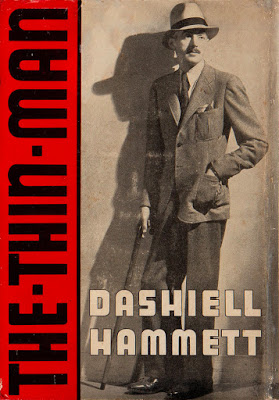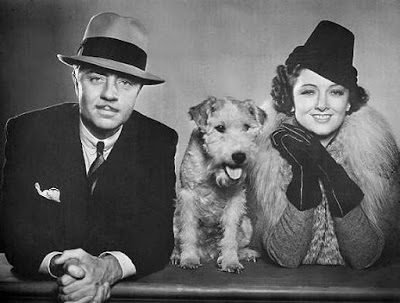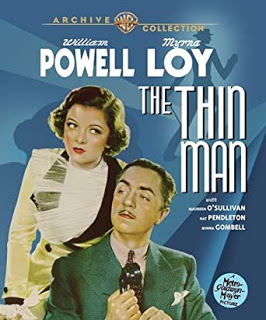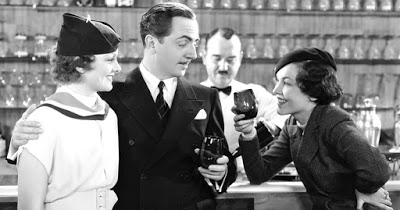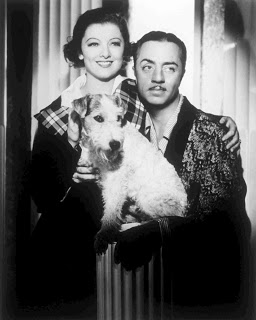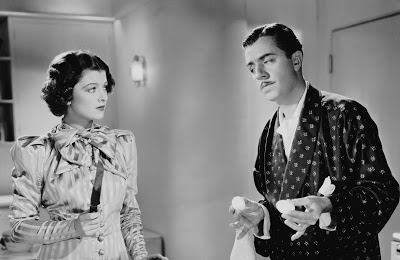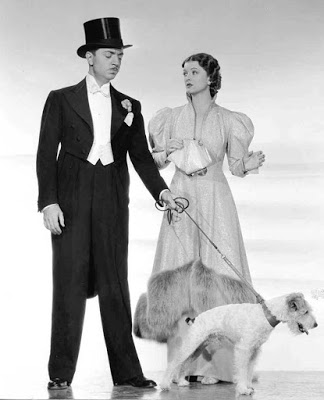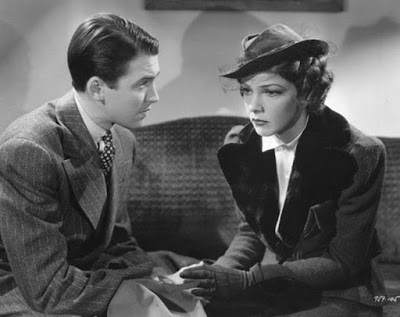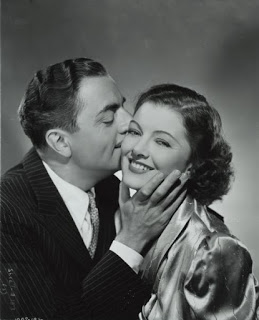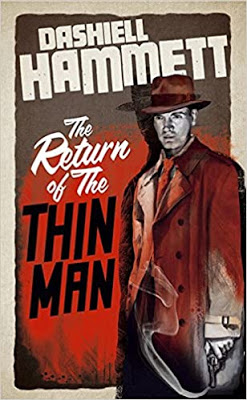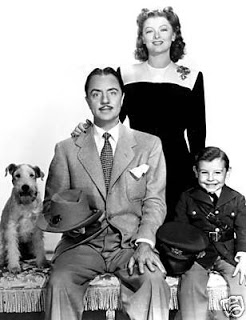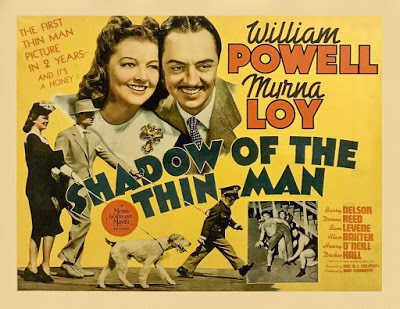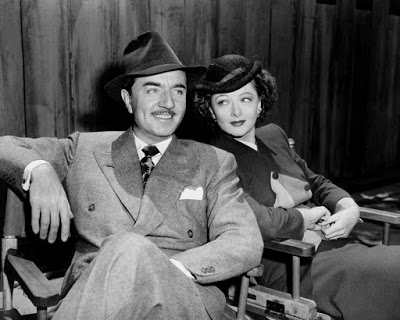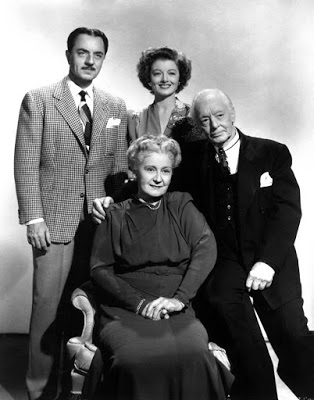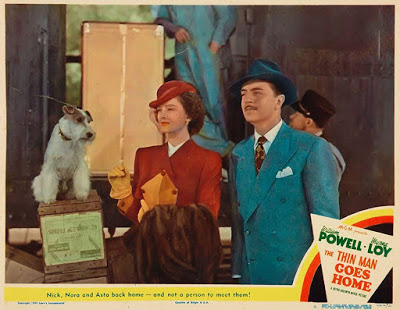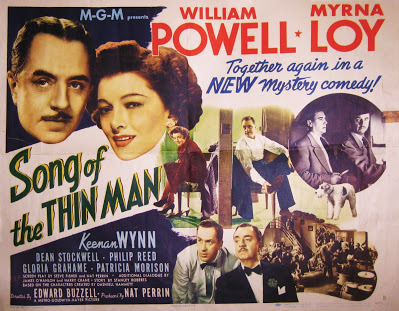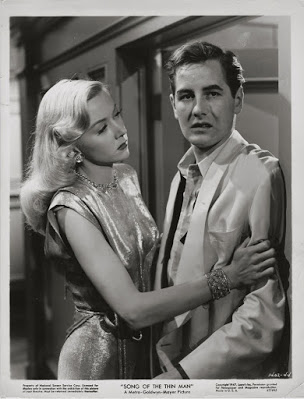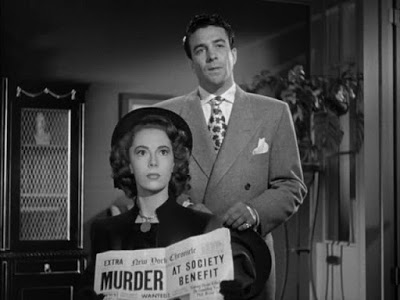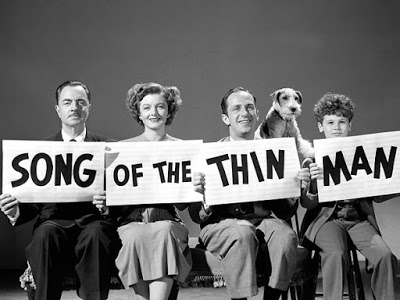The Thin Man (1934) – 8.0
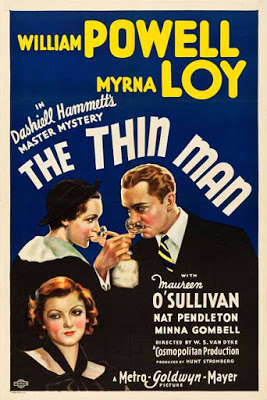
By the time Dashiell Hammett finished The Thin Man in 1934 he already had
written four crime novels - Red Harvest, The Dain Curse, The Maltese Falcon
and The Glass Key. They are all considered classics - not just as crime novels
but as American novels. Hammett was up there with Hemingway, Fitzgerald and
Faulkner. His writing is so clean, concise and to the point. As they say,
he took murder out of the parlor to the back alley where it belonged. Hard
boiled noir had been around for a while but it was generally considered pulp
and not highly regarded. Till Hammett. Film versions of all of them have
been made. The basic premise behind Red Harvest has been made into Yojimbo
and A Fistful of Dollars. The Maltese Falcon was made in 1931 and then later
with Bogart in 1941. The Glass Key was adapted twice as well in 1935 and
in 1942 with Alan Ladd, Veronica Lake and a brutal William Bendix. The Dain
Curse only once in a TV mini-series with James Coburn. Sam Spade the quintessential
detective of our collective imagination is Hammett's.
Part of the reason that he wrote so authentically about the world of murder
and crooks is because he spent seven years with Pinkerton, the famous national
detective agency - with a leave to enlist into WWI where he got TB. One of
his duties in the agency was breaking strikes - something he so regretted
later on that he became a card carrying Communist. After the success of The
Glass Key, Hammett was enticed to Hollywood to write scripts or fix others
(often not credited). He was also trying to finish The Thin Man. But like
Nick Charles in the Thin Man who detects between bouts of drinking, Hammett
wrote between bouts of drinking. The Hollywood life style and having a lot
of money for that Depression period, threw him off the rails. Partying, drinking
and a steady flow of prostitutes left him little time for working. When he
went on a bender it could last weeks. He had also begun an affair with Lillian
Hellman. Much of this is echoed in The Thin Man. More so than the film, the
book is a non-stop drinking binge - never drunk but always with a drink in
the hand and the witty equal relationship between Nick and Nora is clearly
patterned after his with Hellman.
Hollywood basically destroyed Hammett's career as a writer. The first four
novels plus lots of short stories took him three years. The Thin Man
also took him three years. It shows in the writing. It is a very popular
novel but it meanders, has scenes that seem to be there only for the sake
of color - his weakest novel for sure - though the dialogue is still sharp
and funny and was used in the film. MGM bought the rights before the book
was finished for $21,000 - now $350,000 in today's money. More money for
drinking and whoring. And that was basically it for Hammett. He never wrote
another thing for publication - and only worked when not drinking on the
screenplays for the next two Thin Man films. And he lived many more years
but just could not write. One of the more tragic cases of writer's block
ever.
Now MGM had to cast the film. This was not considered a high profile film
and was given a medium budget. A few steps above a B film. Nat Pendleton
as the main cop was a good indication of this. He was in loads of B films
usually as a not so smart cop or criminal but not here where he is a solid
cop but still needs Charles to figure it out. MGM had to find the right couple
with the right chemistry. They had just signed William Powell who had been
Philo Vance in a few films early in his career. He had looked good with Gable
in Manhattan Melodrama which had just been released. Famous for the film
that Dillinger went to see when the cops shot him dead. In that same film
was Myrna Loy. Powell and Loy had something there. Loy had spent most of
her career in exotic hell playing an assortment of ethnic characters often
with an evil intent. Her best has to be in The Mask of Fu Manchu in 1932
in which she plays the daughter of Fu Manchu and enjoys torturing people.
It is an amazing film actually. Now though she was finally stepping out of
those roles and they chose her for Nora. Nora was the beginning of her being
the perfect wife image that culminated in The Best Years of Our Lives (which
should have had Powell playing the character that Fredric March had). No
one can say anything wrong about Loy as far as I am concerned - not her career
or her life in which she did many good deeds. I don't know about being the
perfect wife but she was pretty damn close to being perfect.
There were no expectations for the film by MGM. A solid mystery. But the
chemistry and the clever repartee between Nick and Nora and the enormous
charm of the actors made it into a big hit. It is a lovely film. The writers
cut out all the meandering scenes in the book and focused on the really good
scenes like the cocktail party, the guy who comes in with a gun, the dinner
denouement party and the affection between the two characters. They went
on to make five sequels over thirteen years - none as good as the first but
still it is Nick and Nora and Powell and Loy. Powell and Loy were to be matched
up by MGM in a number of other films. Hammett said of his characters "Nobody
ever invented a more insufferably smug pair of characters". Well they kept
him out of hock for a lot of years.
Plot wise the film sticks closely to the book. The only real difference I
noticed was the character that Maureen O'Sullivan plays. In the book she
is a total party girl, drunk much of the time or suffering a hangover - while
the film's character is none of that. A sweet gentle loyal to her father
girl. She is the one who goes to Nick while he is showing bartenders the
right way to make a martini and asks him to look into her father's disappearance.
He is not really interested though as he is in NYC for a vacation and drinking
is his main priority. And his wife who shows up being dragged by Asta. Nora
is also very rich. And does these cute things with her nose. But everyone
thinks he is involved so he is slowly drawn in and the murders pile up. It
is a good mystery though not something by now we haven't seen a hundred times
- in the book there are even more red herrings - it is simply Nick
and Nora. They are wonderful. Great timing and in the last shot of the film
on the train Asta is put into the top bunk and hides his eyes letting you
know what is going on in the bottom bunk. Not Code watchable. Also a few
other names you may recognize - Cesar Romero, Porter Hall, Harold Huber and
Edward Brophy - again an indication that this was close to B film territory.
Directed by W.S. Van Dyke.
After the Thin Man (1936) – 7.0
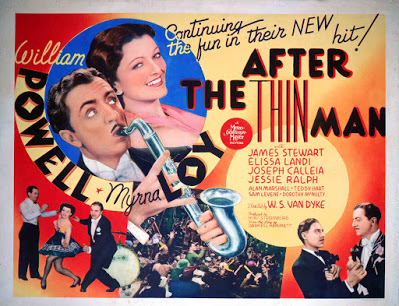
I read a book I bought at the used bookstore here the other day. It is Dashiell
Hammett's two film scripts for sequels to The Thin Man. I never knew these
existed. But after the success of The Thin Man in book and film form (1934)
the public wanted more. MGM hit gold with William Powell and Myrna Loy as
Nick and Nora so they contracted out to Hammett to write a script for them.
Hammett though wasn't easy to work with as he would go on benders that would
last months and usually end with him in a sanitarium drying out. He wrote
often to his wife Lillian Hellman about his struggles to stay focused and
sober.
But he managed to write two screenplays - After the Thin Man and Another
Thin Man - before he went into a complete bunk. Hammett was a great writer
- I love his clipped prose and hard boiled plots - The Maltese Falcon is
a gem of a book and his Continental Op detective in Red Harvest (which had
its plot borrowed by Kurosawa for Yojimbo and Sergio Leone for A Fistful
of Dollars) and The Dain Curse and then the beautifully cynical The Glass
Key about corruption and murder in small town politics. The Glass Key was
made into a film twice - in 1935 with George Raft and in 1942 with Alan Ladd
and the inimitable Veronica Lake. The first one stayed much closer to the
source.
The scriptwriters stay pretty faithful to Hammett's story besides moving
one of the dead bodies to a later part of the narrative. His story which
is sort of a hybrid script novel had a lot of clever quips in it and a decent
mystery. This is the one with Jimmy Stewart near the beginning of his career
but many of his trademark gestures and speech patterns were already in place.
Another one of the changes that the scriptwriters made was having Nora get
pregnant at the end of the film. The reason they did that was because they
were hopeful that having a child would kill off the series. They hated the
Thin Man series. No such luck. They got stuck doing the next one as well.
This one picks up where the last film left off with Nick and Nora on the
train back to San Francisco. They are still at it. Drinking that is. One
of those things you just don’t see in today’s films unless it is about alcoholics.
Nick nearly always has a glass in his hand. They get to their palatial home
overlooking the Golden Gate Bridge only to discover there is a New Year’s
Party going on – in which they know absolutely no one. Drinking their best
booze. Napoleon brandy. They get invited to a wax museum – I mean Nora’s
ancient family all a step away from meeting the coroner. Nora’s cousin Selma
(Elissa Landi) has her husband missing – he turns up dead and the mystery
is on. They turn up the comedy here – even having Asta needing to protect
his honor – much of it droll and amusing. Their chemistry holds up fine.
Another Thin Man (1939) – 7.0
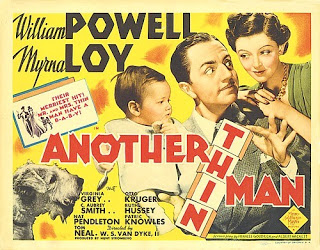
Hammett wrote a treatment for this 3rd in the series. He was drunk for much
of the process and it clearly shows in his writing. It is an awful messy
read which makes it really surprising at how well the film holds together
and also remains amazingly faithful to his story. It is just so much better,
sharper and less confusing in the film thanks to Francis Goodrich and Albert
Hackett. They were married at the time and had written the screenplays for
both The Thin Man and After the Thin Man as well. All three scripts are clever
and witty full of great dialogue. They really wanted to get out of writing
more Thin Man scripts though and had added the baby at the end of After the
Thin Man in hopes of killing the series. Instead Hammett was now forced to
keep the baby in his story and if this baby isn't autistic I don't know who
is. I don't think they even had a term for it back then but Hammett describes
it perfectly. The scriptwriters of course make the child cuter and warmer.
The film never stops to catch its breath and that is a good thing - the quips
and the plot come at you like a hurricane and if I hadn't read the book I
am not sure I would have guessed who the killer was. At the end of the second
film Nick and Nora are on a train headed east after solving a murder case
in San Francisco. In a very sweet scene Nora is knitting and Nick takes it
in his hand – looks puzzles – and says this looks just like a baby mitten.
It finally dawns on him what it means. The camera pans to Nora looking lustrous,
happy and stunning. “Some detective you are”, she says. End of film. It must
have been a very slow train because this film takes up with them arriving
in NYC with a one-year old baby boy. They are soon called out to the house
of the man who runs their business (C. Aubrey Smith) out on Long Island.
A big mansion with lots of guards. Their financial manager thinks his life
is in danger and wants Nick to talk to the man who is threatening him (Sheldon
Leonard) but that doesn’t go well and soon the victims begin to pile up.
A complicated clever mystery with loads of characters in and out of the story.
That is one of the great things about these films – the use of character
actors that inhabit the film. Nick knows every trickster in the city having
sent many of them to the hoosegow.
There is a stellar character cast here - lots of recognizable faces - one
of my favorites was Shemp Howard as one of the birthday mugs who a few years
later was to become one of the Three Stooges. The daughter is played by Virginia
Grey, the mysterious nanny by Ruth Hussey, Patric Knowles and Tom Neal are
the two guys in love with the daughter, the Superintendent is Otto Kruger,
Nat Pendleton is back as the same cop he played in the first film, Marjorie
Main as the understanding landlady and Don Costello as the glass wearing
thug. Excellent if at times a bit confusing but Nick explains it to us dummies
in the end.
The Shadow of the Thin Man (1941) – 7.0
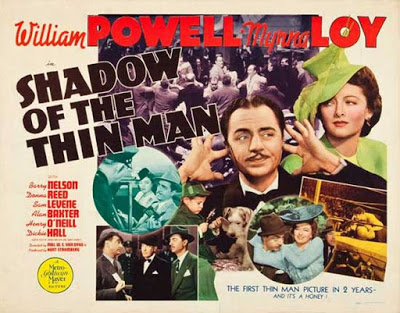
In the first three Thin Man films there was input from Dashiell Hammett and
screenplays written by the team of Francis Goodrich and Albert Hackett. All
three of them were entirely sick of the Thin Man and wanted nothing to do
with this, the fourth film. The director though remains the same, Major W.S.
Van Dyke though this was to be his last Thin Man outing. These films were
never considered B films and they were not rushed out but had a few years
between them. The dialogue isn't as sharp as the previous films but they
make up for it with some stand-out scenes and Myrna Loy's hats. She wears
a series of hats with each more absurd than the last. The one thing about
Nick and Nora is that they are immensely rich - her money - and live a life
of exquisite luxury, a constant stream of martinis and lovely clothes. This
during the Depression of course like so many Depression comedies - but their
magic is how little they flaunt it. It feels like they deserve it. We would
not mind the rich so much if they were like Nick and Nora.
It is hard to imagine any other two actors in these roles now. Powell is
unflappable, charming, casual, witty and everybody's friend from the high
to the low. And Myrna Loy as Nora always is like a shining light that will
never go out - playful, forgiving and close to perfect. Of course now they
are stuck with a kid - a boy of about 3. The former scriptwriters had done
this on purpose in hopes of killing the series. Hammett hated it. But the
kid has survived and is immensely annoying. Not enough to ruin the film but
certainly to ruin every scene he is in. Powell had been a high paid actor
since the early 1930s - he had signed up with Warner Brothers for $6,000
a week - an enormous salary at that time - but when tough times hit the studio
they asked him to take $4,000 and when he refused they jettisoned him. MGM
picked him up. Some of his Warner Brothers films are supposed to be quite
good but does anyone know them and how many people know of many of his MGM
films other than the Thin Man and My Man Godfrey. The Thin Man made him famous
and loved all these many years later. And they took Loy from her exotic multi-ethnic
roles to be everyone's favorite wife on screen.
It is funny how the mind works. I last saw this well over a decade ago -
maybe longer - and the only thing I remembered was who the killer was. Blank
on everything but as soon as I saw the person I knew that was the killer.
It is a simple enough plot - there is a gambling syndicate and a reporter
Paul Clarke (Barry Nelson) is investigating them. His girlfriend is Donna
Reed. Ah, Donna Reed. I spent a lot of time with her growing up watching
TV. When a crooked reporter gets murdered, Clarke is taken into custody.
He happens to be a friend of Nick and Nora and so they look into it. Lots
and lots of great character actors in this one and some fine standalone scenes;
in particular the scene at the wrestling match with a load of moving pieces
and one of Nora's hats taking center stage is really well done. The moll
of the top gambling guy is played by none other than Stella Adler. She would
go on to be one of the most famous acting teachers in film history. She is
also quite good in this. It is a fine addition to the series - not
quite as sparkling or witty but still very enjoyable.
The Thin Man Goes Home (1944) – 7.5
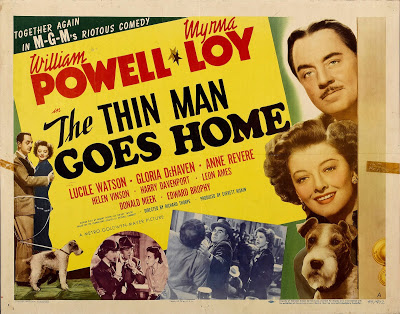
Nick and Nora are back for another Thin Man mystery some three years after
the last one. Both William Powell and Myrna Loy are still signed up with
MGM and though apparently not thrilled with doing more of the Thin Man, they
realized how popular they were. And they were under contract. These films
were never B films and putting a few years between them kept it relatively
fresh. This is the fifth of them with one more to go. The studio surrounded
the pair (and Asta of course but thankfully no child) here with a terrific
group of character actors. I wasn't expecting this one to be as much fun
as it was - absolutely delightful with an emphasis on comedy more than mystery.
And in the center of the humor is a fabulous turn by Myrna Loy who steals
the show under the feet of Powell. Powell is the straight man and doesn't
seem to mind a bit.
The script from Robert Riskin (how about these credits - You Can't Take It
With You, Meet John Doe, Lost Horizon, Mr. Deeds Goes to Town, It Happened
One Night) and Dwight Taylor (Top Hat, Follow the Fleet, I Wake Up Screaming)
is light on its feet and doesn't waste a minute. They take Powell and wife
out of noir territory into the sunny small New England town of Sycamore Springs
where Nick's parents live. They are a version of the Andy Hardy parents.
So is the town where there are no mysteries or vices - until murder literally
shows up on the doorstep of Nick's parent's home. There turns out to be plenty
wrong in this town. Everybody has secrets.
The denouement is a classic. It goes on for nearly 20 minutes and is pitch
perfect full of humor - a play by play from Nora - and a room full of guilty
looking suspects. But again Nora is the highlight here. Trying to convince
Nick's father that Nick is a genius she tells of one of his cases in which
he figured out that Stinky the cripple is the killer and the cops were dopes
- it is hilarious. In another instance she trails the man that she is sure
is the killer and he leads her on a merry walk - once she has to stop in
front of a barber shop full of men (Mike Mazurky in a bit part) and they
all come running out - then through a pool hall disrupting the boys. And
then she has to do a jitterbug. She is magnificent. The chemistry between
Nick and Nora has never been better - like putting on old slippers for both
of them. There is a weird scene though in which Nick puts Nora over his knee
and spanks her as the parents look on and laugh. Apparently, Loy really hated
that scene and didn't want to do it but she ended up having to.
In the cast are Gloria DeHaven as the dramatic teenage daughter, Henry Davenport
and Lucille Watson as the parents (the mom gets a choice laugh when she interrupts
the denouement asking who wants cocoa), Leon Ames as a shady character of
course, Edward Brophy as Nick's man, the wonderful Donald Meek living up
to his name, Lloyd Corrigan as the jovial old friend and Donald MacBride
doing his flustered cop routine. One of them is a killer.
The Song of the Thin Man (1947) – 6.0
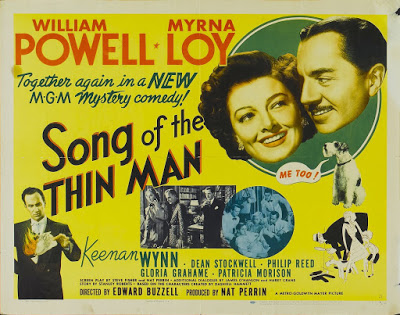
This was the only Thin Man to lose money and MGM cut its oxygen cord like
a man would his rich wife's in a hospital bed. It was just as well. This
is still fine but it lacks the subtle humor and energy of the other ones.
Both Powell and Myra Loy look older and bored at times. They made six Thin
Man films over 13 years - the last one being in 1944. Loy had been unhappy
with the series for a few years now and MGM had let her out of her contract
only if she promised to return for any more Thin Man films. Both she and
Powell had been through life's ups and downs in their personal lives. She
was on her third marriage with one more to go. Powell had been married for
15 years but divorced his wife to marry Carole Lombard but had divorced her
as well and was planning to marry Jean Harlow when she suddenly died at 26.
He almost died from cancer in 1938 and MGM was planning on bringing in new
actors for the Thin Man series. He had become a star a little later than
many and was now 55 and he looks it. Myrna was 43 and still looks like the
Cat's Meow. She was to go on to many more films in her career though her
most famous (other than the Thin Man films) was perhaps made the year before
- The Best Years of Our Lives.
It is a bit sad to say goodbye to them at the end. The quality of the films
held up remarkably well over the series, their chemistry always felt fresh
and the films had wonderful moments and good writing. This one maybe less
so but it brings on a good group of female actresses who were basically unknown
at the time. It opens with Gloria Grahame singing a torch song on stage on
a gambling cruise ship. Backstage she spits out a few harsh words and languorously
leans back as if to say get lost and you just want to go with her on a ride
into a dark tunnel and hope you come out with your life and your wallet.
The year before she had that small part in It's A Wonderful Life that people
still talk about.
The leader of the band is murdered and there are almost as many suspects
as there are red herrings which come whizzing by Nick's head. A couple they
know are the prime suspects and so Nick and Nora feel they have to find the
real killer. One of the young couple is Jane Meadows and she is also very
early in her career. As usual it ends with Nick gathering the suspects into
one location in order to flush out the killer. One walks in with his wife
played by Marie Windsor looking like a million bucks but you know she has
a heart of a plug nickel. Another wife played by Patricia Morrison who is
a stunner has a great finale with a gun in her hand. You want to applaud
her.
One of the best parts of the film is when Keenan Wynn as a hip talking jazz
player takes them on a round of after hours places where the jazz players
meet to jam. There was some good blowing in there. Within a few minutes Nora
is talking jive as well. Oh, and their kid is about ten now and played by
Dean Stockwell. By the way, in case you don't know and it comes up on Jeopardy
- Nick is not the Thin Man. The Thin Man was a character in the novel and
first film who had disappeared but was described as thin. The name stuck.
